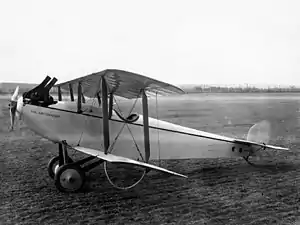Dayton-Wright Messenger
The Dayton-Wright T-4 Messenger was a light, single-seat reconnaissance aircraft built in the United States by the Dayton-Wright Company in 1918 in the hope of gaining a production contract from the United States Army. It was a small conventional single-bay biplane with a neatly streamlined fuselage and staggered, equal-span wings. The undercarriage was of fixed tailskid type and the pilot sat in an open cockpit. Although diminutive, the design in fact started life as a scaled-up version of the Dayton-Wright Bug and shared a family resemblance to the de Havilland DH.4 that Dayton-Wright was building under licence during World War I. When the US Army was not interested in the aircraft, plans were made to sell it on the civil market, but these came to nothing and the prototype was the only example ever built.
| T-4 Messenger | |
|---|---|
 | |
| Role | Reconnaissance aircraft |
| Manufacturer | Dayton-Wright |
| Designer | Oliver Thomas |
| First flight | 1918 |
| Number built | 1 |
Specifications
Data from General Dynamics Aircraft and their Predecessors[1]
General characteristics
- Crew: One (pilot)
- Length: 17 ft 6 in (5.33 m)
- Wingspan: 19 ft 3 in (5.87 m)
- Height: 6 ft 1 in (1.85 m)
- Wing area: 106 sq ft (9.8 m2)
- Empty weight: 385 lb (175 kg)
- Gross weight: 636 lb (288 kg)
- Powerplant: 1 × De Palma two-stroke V-4 engine, 37 hp (28 kW)
Performance
- Maximum speed: 85 mph (137 km/h, 74 kn)
- Endurance: 2.5 hours
- Time to altitude: 10 minutes to 3,000 ft (900 m)
References
- Citations
- Wegg 1990, p. 37.
- Bibliography
- Jane's All the World's Aircraft 1919. London: Sampson Low. p. 455.
- Taylor, Michael J. H. (1989). Jane's Encyclopedia of Aviation. London: Studio Editions. p. 305.
- Wegg, John (1990). General Dynamics Aircraft and their Predecessors. London: Putnam. ISBN 0-85177-833-X.